As the dust has settled down on the much hyped meeting between President of the United States (POTUS) Mr. Donald Trump and Kim Jong-un, the supreme leader of North Korea (DPRK), and after the experts have had their say on denouncing the outcome of the meeting in many catchy phrases - like "diplomatic coup by Kim", "Kim Jong-un - the story of a boy dictator who bested the US President", "President made a shocking deal" and more - this article attempts to analyse the nuances of this so called skewed agreement, flagging the compulsions of the US in executing it .
The start point of the analysis is the four primary points of the joint agreement. These are stated below1:-
1. The United States (US) and DPRK commit to establish new US-DPRK relations in accordance with the desires of the peoples of the two countries for peace and prosperity.
2. The US and DPRK will join their efforts to build a lasting and stable peace regime on the Korean peninsula.
3. Reaffirming the April 27, 2018 Panmunjom Declaration, the DPRK commits to work towards complete de-nuclearisation of the Korean Peninsula.
4. The US and DPRK commit to recovering of prisoners of war/missing-in-action (POW/MIA) remains, including immediate repatriation of those already identified.
At the outset, there is no doubt that in going head-on-head with President Trump in an international Summit “as equals”, and on all counts winning a major diplomatic success therein, the ‘boy dictator’, who is accused of ordering the assassination of his half-brother, who publicly arrested and executed his uncle Jang Song-thaek, who is accused of crimes against humanity (mass killings, brutal executions, starvation et all), has more than 120,000 political prisoners under his thumb and who is presiding over an isolated state ridden with sanctions, actually won for himself, legitimacy as an “international statesman” and a head of a nuclear power. Getting the POTUS at the negotiating table, the first by a sitting President2, provided him a kind of legitimacy that also came gift-wrapped in US guarantees for security. This gave Kim a licence for survival and a go ahead to preside over his authoritarian dictatorship for long years into the future. A “diplomatic coup” indeed.
While all the above and more may stand on the side of the victorious, look at the residual scene that obtained in the US Camp just prior to the summit indicates that in the face of growing belligerence of the dictator’s regime in successive testing of nuclear capable missiles of claimed range capability to reach US mainland, the latter was actually “running out of options”. For instance, when the POTUS, in reciprocation to the acts of DPRK, made an announcement in August last year, that there will be “fire and fury like the world has never seen”, it realised the practical limitations (read infeasibility) of actually executing the “fire and fury”. He knew very well that the resultant outcome of that action will actually engulf the planet in an uncontrollable nuclear exchange, with the US in the eye of the storm and with millions of deaths on either side as also elsewhere.
Any amount of overt display - exercises, war games, flights of bombers in close vicinity etc. – notwithstanding, in the game of nuclear weapons deterrence plays only up to the outer limit of the “threat to exercise the nuclear option”. This was understood by both sides.
Getting back to US, so there was an ‘ultimate option’ (do-able with disastrous consequences) on one side and doing nothing on the other. Besides, critics at home were lapping accusations on the President for pushing the US to war - ironically the same critics are now accusing him of moving too quickly to peace!3. In essence therefore, between the scenario of ‘no option’ (read non-executable option) and a chance to get a move on, get some political maneuver space, and generate some alternatives, the President has chosen the latter.
All the criticism on what a great bonanza the President allowed Kim to walk away with while giving so little is actually well founded. Legitimacy, security guarantee, suspension of exercises with a major ally, promise to ease sanctions, opening the window for the ‘neo-international statesman’ to open economic and trade dialogues with possibly Russia, South Korea and Japan from the new-found position of equality, and more, have all been debated at length. Similarly, the other criticisms like the vagueness of the term “de-nuclearisation of the Korean Peninsula”, the absence of any time-bound programme for action or a verification regime, allowance or otherwise of international inspections and more are also un-deniable.
Talking of “de-nuclearisation of the Korean peninsula”, the well-known strategic thinker, Brahma Chellaney has explained, that such a term actually means creation of a “nuclear-weapon-free-zone (NWFZ)” on the entire Korean peninsula. Such a zone will not only demand DPRK’s de-nuclearisation, but also, important concessions by US and South Korea (and by the other two nuclear powers in the region, namely, China and Russia, to ensure that the Korean Peninsula actually remains a NFWZ4. Is such an end-state imaginable at this point in time, or in the foreseeable future? No, that is the sense of the author.
Experts have argued that Kim will not be so naive as to give away the weapons which actually compelled the most powerful leader of the world to sit across the table as an equal, which won for him security guarantees for his country and legitimacy for his rule, which permitted opening the possibility of loosening up on international sanctions and the one which compelled the US to call a halt to military exercises with the South Korea (People’s Republic of Korea, or PRK)5.
So what Kim is likely to do as to the de-nuclearisation bit? There are several possibilities:-
1. Kim may destroy a missile engine site as per an assurance which the President said he secured post signing the joint agreement.
2. Kim may destroy such long range missiles which threaten the US but may retain its short and medium range arsenal.
3. Kim may do no destruction, but may put a freeze on future testing and development of nuclear capability.
4. Kim may hide behind the opaque curtain of vagueness contained in the term “complete de-nuclearisation of the Korean peninsula” and start demanding concessions from other players (especially US and South Korea, Japan, China, Russia ) or may start an endless cycle of vague negotiations while at the same time taking his country forward on the economic agenda.
Each of these options is briefly enumerated.
Destruction of a missile engine site is just a farce as the same is ridden with so many ruses. Which site to destroy? DPRK has several test facilities scattered across the country, each with a different role to the nation’s missile programme. Could it be a site which has already been dismantled on 06 June, 2018, (Iha-ri Driver Training and Test facility) being showcased as a fulfilment of the promise made? Could it be a site whose role has already been accomplished? Experts have identified one such site used to test cold-launch technologies for mobile missiles. Could it be a stage-managed destruction affair for the sake of keeping a promise? Same was the case during at the Iha-ri Driver Training and Test facility whose so called destruction was actually stage-managed for the western media with no nuclear experts, inspectors or engineers to verify the claim. The explosives were so placed that the facility could come up again shortly after the public relations (PR) exercise.

With no clarity or agreement on the presence of international nuclear experts, engineers and inspectors, the agreed destruction will be something that will have to be believed on Kim’s word. Given the ridiculousness of such an assurance, the same can be discounted here as “irrelevant”.
In executing the second stated option of destroying the long range missiles and retaining the short and medium range arsenal, Kim may play to the narrow American interests while keeping his ones secure. The residual position will be that while the sting that hurts the US is removed or diluted in return for the guarantee of security (hence the continued survival of the regime), the power to flex the nuclear muscle in the regional context will be retained.
In the above case, while the security guarantee of the US with DPRK is offered for keeping the threat away from its doors, the US will have to continue to stand in with reciprocal nuclear guarantee for PRK and Japan in response to the retained regional nuclear capability of DPRK. Then what happens to the commitment of “complete de-nuclearisation of the Korean peninsula”? It goes out of the window; what else.
While the above option stands stated as an option per se, it will really require somebody out of his senses to cut the branch on which he is sitting. After all, it was the credibility of the nuclear muscle of DPRK in its capability to knock at Guam that brought the President to the negotiating table besides opening a whole world of possibilities; can such a capability be destroyed? In fact, the question does not need an answer.
The third option involves freezing further testing and development of nuclear weapons in return for all that which is listed in the “takeaways” for Kim in his diplomatic coup. It may pertinent to state here that DPRK announced the successful completion of its nuclear weapons programme in November 2017. With this in view, continued testing may not be really critical. This fact may make this option doable to an extent. The residual end position, as one expert has put it, will be, “freeze for freeze”. The second freeze relates to the freezing of the military exercises with PRK.
Talking of suspending of military exercises with PRK, experts are trying to read between-the-lines and measure the extent of damage, if at all. The President has called such exercises as “provocative, inappropriate and expensive”. The supporters of the agreement are calling it a "goodwill gesture to facilitate DPRK’s de-nuclearisation” (sadly missing to read that de-nuclearisation of Korean peninsula, is not same as DPRK’s de-nuclearisation). The naysayers are calling it a blow to bilateral alliance. China is marking it as a victory achieved in proxy, for widening the spaces in the strategic alliance between US and PRK. Currently, the PRK and US military authorities are having close consultations over the combined exercises the results of which will be announced shortly.
Be that as it may, the sense of the author converges on two bottom line points. One, absence of actual military exercises does not mean that there will be lack of combat readiness in taking on any contingency. There are any number of alternate ways to keep one’s powder dry; and two, there is always a “snap back” clause in the announcement, wherein, the exercises could resume should the communist regime fail to deliver on its de-nuclearisation commitment.
It is the sense of the author that fourth and the last option of hiding behind the imbroglio of a vague term and the near impossibility of achieving the “complete de-nuclearisation” is the most viable option the DPRK is likely to follow. By the way, the nuclear puritans are trying to realise the utopian dream of complete de-nuclearisation for nearly a century now and counting.
That notwithstanding, DPRK can easily start by defining what a complete de-nuclearisation of the Korean peninsula means, and commence demanding reciprocal actions from the PRK and Japan (implying the removal of nuclear US umbrella), besides asking for guarantees from China and Russia to keep the area free from nuclear weapons. How long-winding this road of negotiation could be and how infinite amount of time could be bought by the DPRK sounding righteous (as a state that is pioneering the ushering of a de-nuclearised Korea) and sitting safe (having secured for itself, a continued survival of the regime).
In this pursuit, it could keep the game in “eternal play” by asking for some impossible conditions while at the same time continue to drive the economic growth agenda through multi-polar engagements with world players in an atmosphere of diluted sanctions. China has already started talking of complete removal of sanctions against the DPRK and some South Korean companies are “eager to invest”!
So what the US has got out of this? A possible move out from a dead-end and a practically un-doable road-head to a by-lane where there is some possibilities and some political manoeuvre space. In an effort to mop up the spoils of a perceived “sell out summit”, the US experts have already started making some noises such as a step-by-step programme for de-nuclearisation of the DPRK: (1) freeze testing; (2) cap arsenal; (3) dismantle infrastructure; (4) disarm6. This appears to be nothing more than a dream at this moment.
There are some other tangible and intangibles that the signed document indicates. An attempt has been made here to read between-the-lines7.
The first point of the agreement where the two countries commit to establish new US-DPRK relations based on peace and prosperity, clearly signals a departure from a mutually hostile positions taken heretofore.
Not long ago, DPRK’s state propaganda department routinely painted US as an enemy nation bent on destroying the regime and its people. The US on the other hand talked of “fire and fury”. How much the two sides are committed to what they have signed, only time will tell, but it is a marked departure all the same from fierce postures of reciprocal hostility to a possible path of reconciliation. This feels like a gamble at this point in time.
It also shows the shrewd sense of time and judgement for Kim. In that, he first completed the development of his country’s nuclear capability to a point of such a credibility that brought the POTUS to the negotiation table. With that in hand, he turned the focus to such goodies as peace, prosperity, development and reconciliation, making a smart and a shrewd move of taking the shortest route to legitimacy and security. Surely, nuclear weapons could not achieve more than what they did for Kim.
The second point of agreement, talking of building a lasting peace regime on the Korean peninsula, is actually immersed in vagueness. With no direct commitment to convert these sentiments into any form of peace treaty these are loose ‘feel good’ sentences echoing the sentiments of the Point 1 of the agreement.
The ramification of the third point related to complete de-nuclealisation of the Korean peninsula has been discussed in detail as to what it means and what it does not, what options lie in front of the DPRK and which out of these is most viable.
To say that it may be a harbinger of the US's dream of complete, verifiable, and irreversible disarmament (CVID) of the DPRK’s nuclear arsenal will not only be premature, but also highly incorrect. It may be relevant to note that the Korean leader agreed for the complete de-nuclearisation of the Korean peninsula and not de-nuclearistaion of DPRK. The two are vastly different. What is agreed involves US, South Korea, Japan, China and Russia, as explained. It is a long haul which may never ever start to roll.
The fourth point of agreement related to recovering POW/MIA remains, and immediate repatriation of those already identified has a tangible takeaway for US. Reportedly, there are remains of an estimated 5300 American Service members in DPRK that are potentially recoverable. This if successfully executed, even in part, it will bring cheer to the near and dear ones of the martyrs who have waited for an incredible 65 years. As President Trump stated in an interview, there were multiple requests from the families of the soldiers to bring back the remains.
Finally the reply of the President Trump to a reporter asking why he signed such a skewed agreement sums it all: “because I didn’t want you and your family to be killed with a nuclear weapon”.
Endnotes
1. https://www.abc.net.au>have-we-seen-this-all-before?-the-trump-kim-summit-statement-annotated. Accessed on 16 Jun 18.
2. https://www. the guardian.com>kim-jong-un-the-boy-dictator-that- bested -the-US-president. Accessed on 16 Jun 18.
3. https://www. dailyo.in>why -north-korea-may-become-another-pakistan-on-the-world-nuclear-map. Accessed on 17 Jun 18.
4. ibid
5. https://www. smh.com.au>south-korea-us-to-halt-military-exercises. Accessed on 17 Jun 18.
6. https://www. brookings.edu>what happened at the Trump-Kim summit in Singapore. Accessed on 17 Jun 18.
7. https://www.the guardian.com>what-have-trump-and-kim-signed?-we-read-between-the-lines. Accessed on 17 Jun 18.
(The paper is the author’s individual scholastic articulation. The author certifies that the article/paper is original in content, unpublished and it has not been submitted for publication/web upload elsewhere, and that the facts and figures quoted are duly referenced, as needed, and are believed to be correct). (The paper does not necessarily represent the organisational stance... More >>
Cover Image Source: https://commons.wikimedia.org/wiki/File:Trump_and_Kim_shaking_hands_in_the_summit_room.jpg

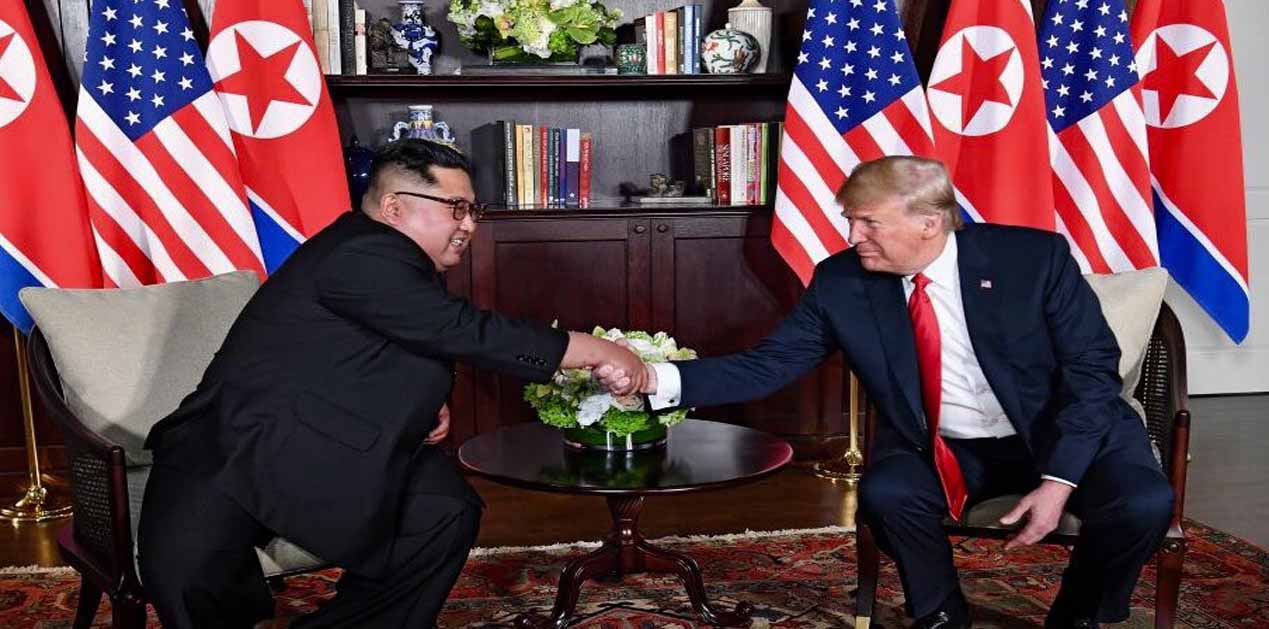
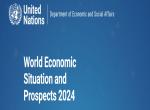
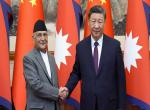


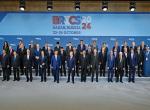

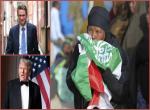
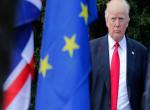
Post new comment